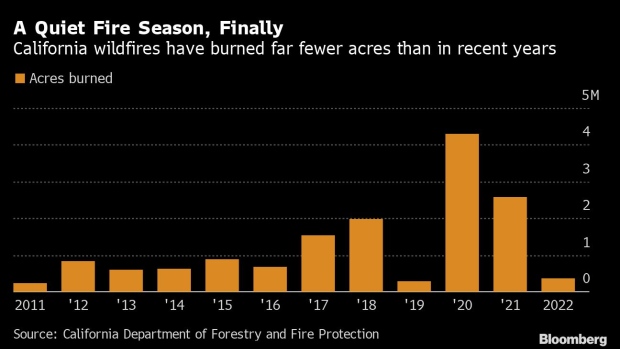Nov 7, 2022
California Fire Season to Get Snuffed Out as Pacific Storm Nears
, Bloomberg News

(Bloomberg) -- Torrential rain and snow will fall over California in the coming days, raising the prospect the state will experience something that’s become elusive in recent years: an early end to wildfire season.
The storms sweeping off the Pacific Ocean will dump up to 10 inches of rain in the San Bernardino Mountains of Southern California and upwards to 5 feet (1.5 meters) of snow in the Sierra Nevadas up north. Forecasters say it will thoroughly soak tinder-dry grasses and shrubs that have given rise to so many out-of-control blazes amid the region’s historic drought.
“Fire season is pretty much going to end with this storm, at least in the north,” said Jeff Masters, a meteorologist and author with Yale Climate Connections.
The storms mark a rare break from Mother Nature for California, which has been battered in recent years by heat waves, the worst drought in 1,000 years and the deadliest fires in state history. Many of those blazes have come during late fall, as the Santa Anna and Diablo winds drive flames over bone-dry hills and valleys. And while forecasters warned the drought could make this fire season especially devastating, in the end it’s shaping up to be one of California’s least destructive in years.
Across California, fires have burned about 360,000 acres (146,000 hectares) this year, a fraction of the nearly 2.5 million acres destroyed in 2021, according to the California Department of Forestry and Fire Protection, commonly called Cal Fire. It’s also less than the five-year average of 2.1 million acres.
This year's blazes have nonetheless taken a significant toll, killing nine people and destroying hundreds of homes.
California has been helped throughout the year by the weather, as well as aggressive tactics by fire fighters on any fresh blazes, said Issac Sanchez, a Cal Fire battalion chief. This is the first time since 2019 when 277,285 acres burned that the total lagged the modern trend toward massive fires. Sanchez said “mellow years” do happen from time to time.
The news is welcome after the Mosquito Fire -- the largest this year -- instilled fears early on of yet another potentially devastating season. The wildfire, which is suspected to have been started by PG&E Corp. equipment, charred 76,788 acres and destroyed 78 structures in the Sierra Nevada mountains west of Lake Tahoe.
“At this point, with what has fallen, plus what is forecast, I don’t foresee a meaningful potential for large/destructive wildfires in Northern or Central California for the rest of the season,” said Daniel Swain, a climatologist at the University of California at Los Angeles. “Southern California fire risk will also be very low for a while, though there mid-winter resurgences are more plausible during periods of strong/desiccating Santa Ana wind events.”
Fire season coming to an end in November across Northern and Central California used to be normal, said Swain. “A decade or so ago, that would have essentially gone without saying,” he said.
While the chances of new, large wildfires will be low because of the rain and snow, recent history has shown there can be rebounds if the storms don’t keep coming. A year ago, California also started the rainy season with some heavy downpours and snow storms only to have the spigot turned off, in part by La Nina, Masters said.
“Remember last winter there was a break in the wet season that allowed the fires to come back in the middle of winter,” Masters noted.
La Nina, a cooling across the equatorial Pacific, is holding sway for the third year in a row. When that happens, weather patterns shift across North America moving storm tracks to the north, often leaving California and the southern US dry and mild through the winter months. California gets most of its water through winter rain and snow, with almost half traditionally falling in December, January and February.
With multiple years of below-average winter precipitation, 99.77% of California is in drought, according to the US Drought Monitor. The consequences have been wildfires and dwindling water resources around the state, effects that have spread across the US West.
As of Monday, 60,647 fires across the US have burned more than 7.2 million acres, more than last year and in excess of the 10-year average of nearly 6.8 million acres, according to the National Interagency Fire Center.
--With assistance from Mark Chediak and David R Baker.
©2022 Bloomberg L.P.





